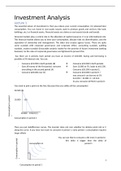Summary
Summary Investment analysis; all you need to know to pass the exam!
- Course
- Institution
Investment analysis; all you need to know to pass the exam! It includes all notes of all lectures, instruction lectures, videos and exercises.
[Show more]



